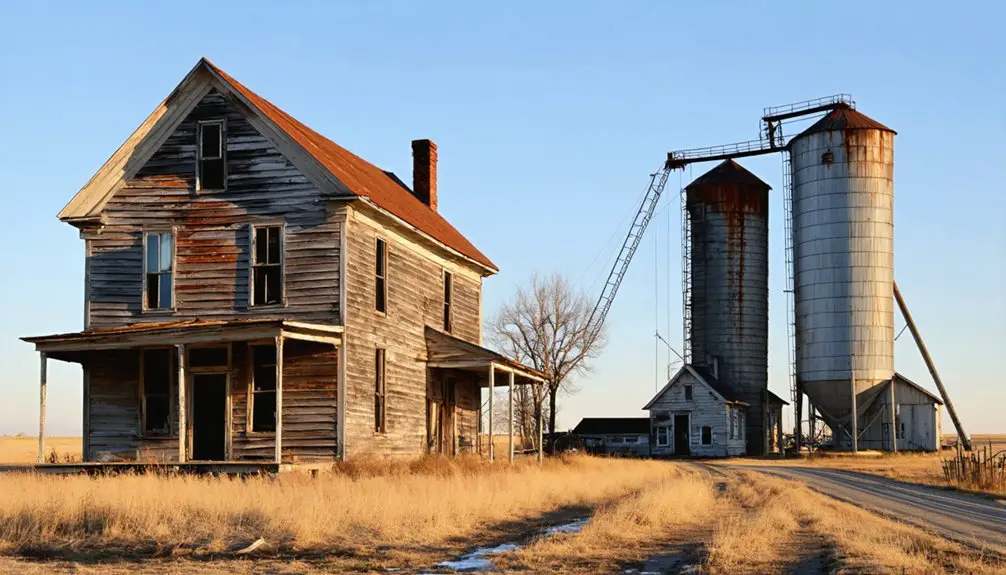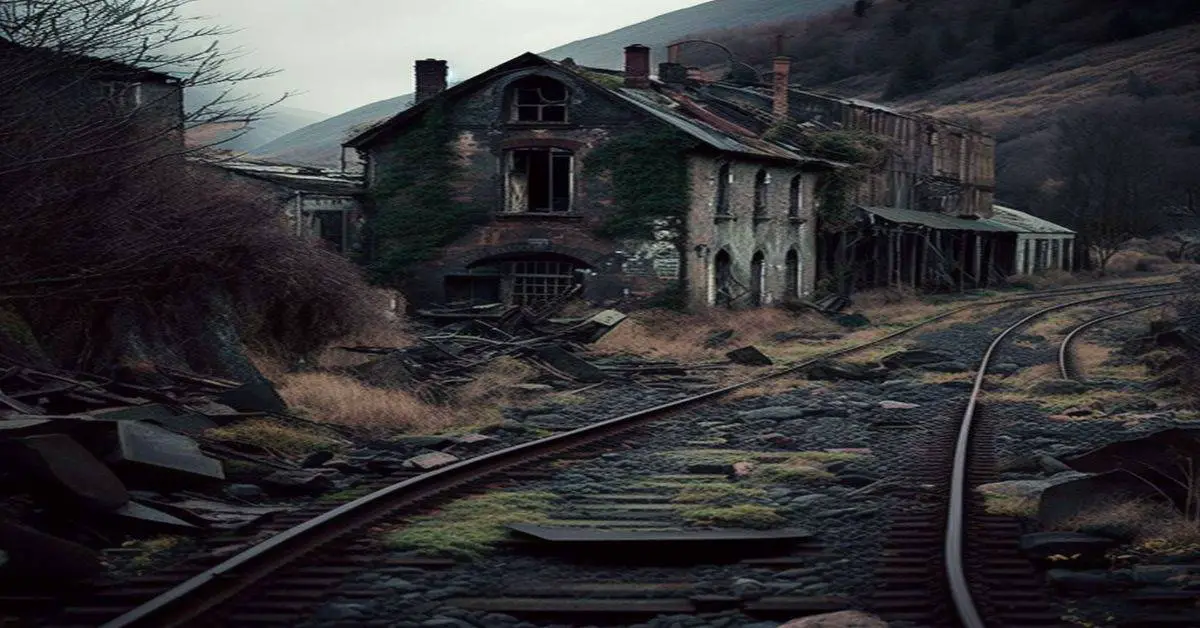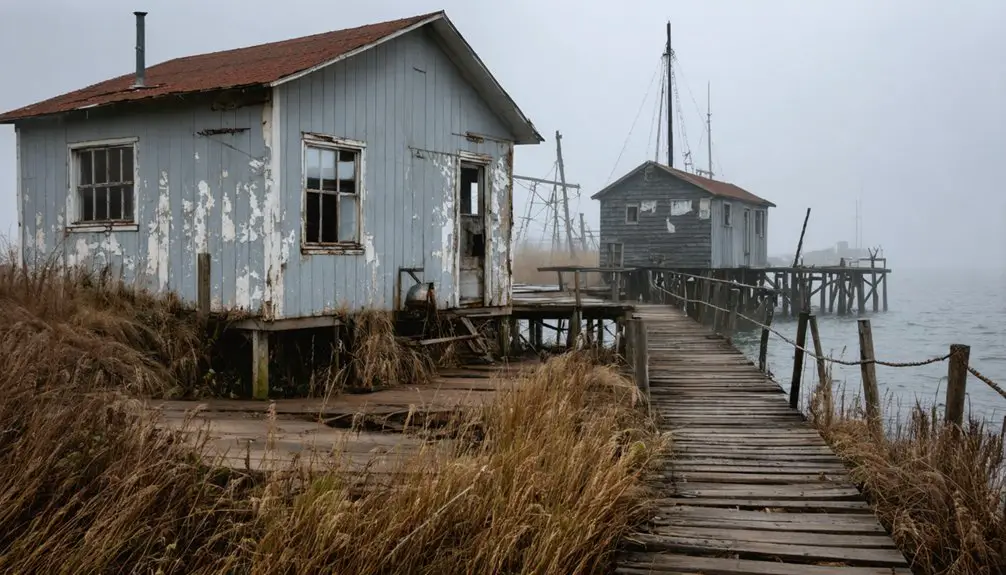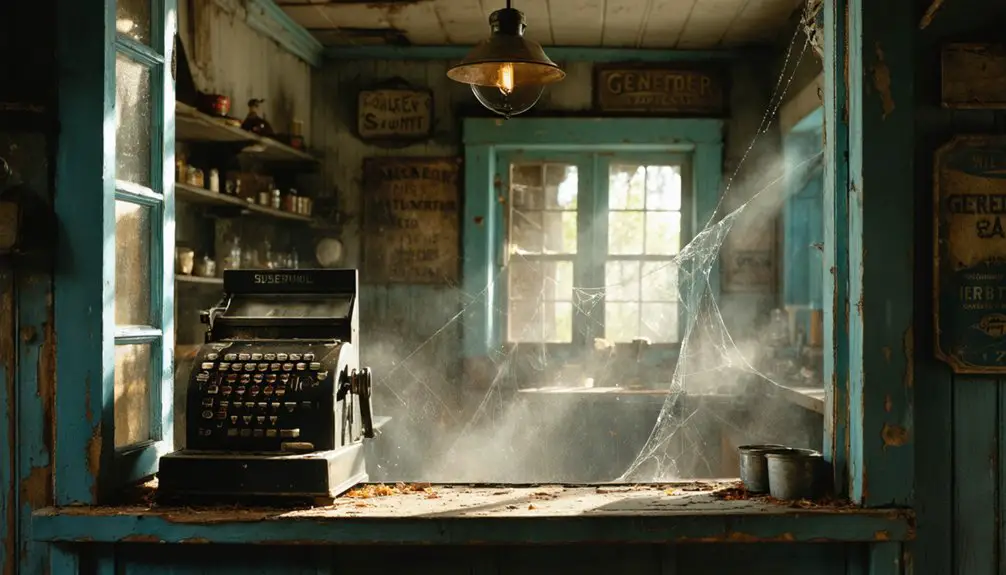You’ll find Donaldson’s ghost town story in northern Wisconsin, where Rudolf Otto’s 1887 lumber mill spawned a bustling community. Under Mason & Donaldson Lumber Co.’s ownership from 1905, the town flourished with a schoolhouse, post office, and company housing clustered around the mill. But the devastating fires of May 1908 destroyed the operation, and when owners chose not to rebuild, residents relocated to nearby State Line. The town’s brief 21-year existence holds fascinating details about Wisconsin’s logging era.
Key Takeaways
- Donaldson was established in 1887 as a lumber mill town by Rudolf Otto on Mill Lake in Northern Wisconsin.
- Mason & Donaldson Lumber Company transformed the town into a thriving logging community with homes, stores, and schools.
- The town’s prosperity peaked between 1905-1908 with a railroad connection, company housing, and community facilities.
- A devastating fire in May 1908 destroyed the mill, and owners chose not to rebuild, leading to the town’s abandonment.
- Today, only earthen berms and depressions remain, with artifacts preserved in Northern Waters Museum and historical society archives.
The Birth of a Lumber Mill Town
When Rudolf Otto established his lumber mill on the shores of Mill Lake in 1887, he laid the foundation for what would become the town of Donaldson, Wisconsin. His single-rotary mill quickly earned recognition as one of Northern Wisconsin’s finest, driving early community growth in the region.
After Otto’s death in 1898, ownership changes brought new developments. The Mather Bros. took control until fires in 1902 caused setbacks, followed by a brief period under Wilbur Lumber Co.
When Mason & Donaldson Lumber Co. purchased the property in 1905, they transformed the operation. They modernized the mill and expanded its capacity, spurring rapid development. The lumber industry’s success attracted workers, leading to the construction of 20-30 homes, a boarding house, saloon, company store, and schoolhouse. A two-room schoolhouse served the educational needs of the community’s children. The 1908 fire ultimately led to Donaldson’s decline, with many residents relocating their homes to State Line.
An essential railroad connection guaranteed the town’s position as a thriving lumber hub.
Mason & Donaldson’s Golden Era
Under Mason & Donaldson’s ownership from 1905, the lumber operation in Donaldson entered its most prosperous phase. You’d have witnessed remarkable logging innovations as the mill, situated on Mill Lake, connected directly to the Milwaukee Lake Shore & Western Railroad via a dedicated spur line.
Mason & Donaldson revolutionized Donaldson’s lumber industry through railroad connectivity and innovative logging practices at their prosperous Mill Lake operation.
This economic resilience marked a stark contrast to earlier challenges, including the Mather Bros. fire losses of 1902. Similar to the war materials sacrifice of Donaldson’s Minneapolis store dome in 1942, the town adapted to changing circumstances.
The mill’s success transformed Donaldson into a thriving logging hub. The town featured a two-room district school that educated local children until 1930. You’d have found a bustling post office serving the community from 1907 to 1913, while workers and their families established homes south of the lakeside operation.
The mill’s output reached both local builders and broader commercial markets, cementing Donaldson’s position as one of Vilas County’s most significant lumber centers.
Life in Early 1900s Donaldson
During its peak years from 1905 to 1908, Donaldson flourished as a close-knit lumber community centered around Mill Lake’s shoreline.
You’d find 20-30 homes clustered near the mill, including company-owned housing and a boarding house for single workers. Daily routines revolved around the demanding work at Mason-Donaldson Lumber Company, while the company store and saloon served as commercial lifelines. Like L.S. Donaldson Company in Minneapolis, the local business was a crucial part of the community’s economic foundation. The community preserved its heritage through digital collections that documented daily life.
The two-room schoolhouse stood as a reflection of the town’s commitment to education, complete with wood floors, stoves, and proper desks.
Community events often unfolded in the dance hall and community building, where residents gathered for social occasions.
The post office, relocated from State Line in 1907, connected you to the outside world, while the telegraph and railroad kept you linked to neighboring settlements.
The Fateful Fire of 1908
A devastating fire engulfed the Mason-Donaldson Saw Mill in May 1908, marking the beginning of Donaldson’s rapid decline.
You’ll find this fire wasn’t isolated – it occurred during a destructive season that ravaged much of northern Wisconsin, causing millions in damages statewide. State reports estimated losses of $5-10 million from the extensive fires that year.
Like the highly flammable materials that fueled the Triangle Shirtwaist Factory Fire, the sawmill’s wooden structures and lumber stockpiles fed the devastating blaze.
The fire aftermath proved catastrophic for Donaldson’s survival. The mill’s owners chose not to rebuild, triggering an immediate economic impact that rippled through the small community of 20-30 homes.
You can trace the town’s dissolution as workers and their families relocated, many physically moving their houses to nearby State Line.
While the local schoolhouse continued operating until 1931, serving 57 students and hosting community events, the town’s fate was sealed.
The post office’s relocation to State Line by 1913 officially marked Donaldson’s transformation into a ghost town.
A Town’s Swift Disappearance
While some towns fade slowly into obscurity, Donaldson’s transformation into a ghost town happened with remarkable speed after the 1908 mill fire. The town’s lack of economic resilience became immediately apparent as residents faced the harsh reality that the mill owners wouldn’t rebuild.
Today, visitors can only find old-school steps and scattered building foundations as evidence of the town’s existence.
Without its economic backbone, the community’s adaptation proved impossible.
- Houses were physically relocated to nearby State Line, following the railroad tracks
- Families departed en masse, leaving behind their once-thriving lumber community
- The company store, saloon, and boarding house quickly shuttered their doors
- Only the schoolhouse remained active until 1930, serving the few lingering residents
You’ll find that Donaldson’s swift decline mirrors many single-industry towns of the era, where economic diversity could have meant survival rather than abandonment.
Much like Imalone, Wisconsin, where tall grass and overgrowth now obscure most remaining structures, nature has reclaimed much of what was once a bustling community.
The Railroad Connection
Throughout the late 1800s, Donaldson’s critical railroad infrastructure centered on a strategic spur line connecting the Mason-Donaldson sawmill to the Milwaukee Lake Shore & Western Railroad’s main line at State Line.
You’ll find that this railroad expansion transformed the region’s logging operations, with companies like Brown Brothers and Salsich & Wilson operating extensive rail networks to transport timber.
The infrastructure included essential pump houses with Fairbanks-Morse engines and water towers to keep steam locomotives running.
When Mason-Donaldson Lumber Co. took over in 1905, they enhanced rail transport capabilities, enabling greater mill capacity and establishing a thriving community.
The rail system’s efficiency attracted workers and businesses, supporting up to 30 homes during Donaldson’s peak years.
Education and Community Spirit
You’ll find that Donaldson School, built in 1903, served as more than just a place of learning – it was the heart of daily community life where local children gathered for education and townspeople convened for social events.
The two-room schoolhouse, featuring traditional wooden desks, stoves, and wood floors, continued the teaching legacy established by Mr. Ebey at an earlier nearby school.
Beyond regular classes, the building hosted Sunday school, church services, and graduation ceremonies until its closure in 1930-1931, demonstrating the tight-knit character of this mill town community.
Schoolhouse Daily Life
As students filed into the two-room Donaldson School each morning, they entered a hub of both education and community life that served the lumber mill town from the early 1900s through 1931.
Inside, you’d find wood floors and desks warmed by stoves during harsh Wisconsin winters. School routines centered around basic academic subjects, with student interactions spanning multiple age groups in the same classroom.
- Teachers like Mr. Ebey helped maintain educational standards despite limited resources
- Students gathered around wood stoves for warmth while studying their lessons
- School records kept in the safe documented daily attendance and achievements
- The schoolhouse hosted everything from regular classes to Sunday school and community events
The building stood as more than just a school – it was the heartbeat of Donaldson’s tight-knit community.
Community Teaching Traditions
While the Donaldson School primarily served as an educational institution, it quickly evolved into the town’s cultural cornerstone where community bonds deepened through shared activities.
You’d find the building bustling with Sunday school classes and church services, fostering both religious education and social connections. The school hosted numerous community gatherings throughout the year, from graduations marking educational milestones to social events that strengthened local ties.
Local craftspeople supported these traditions by contributing their skills, creating exhibits and scale models that preserved the town’s heritage.
Even after the economic decline following the 1908 sawmill fire, the school remained a symbol of community spirit.
Today, you can explore this legacy through preserved artifacts and interpretive displays that tell the story of Donaldson’s vibrant teaching traditions.
Tale of Two Towns: Donaldson and State Line
During the late 1800s, two distinct but interconnected communities emerged in northern Wisconsin: Donaldson, a lumber mill town founded by Rudolph Otto in 1887, and State Line, a railroad-focused settlement established the same year. Just 1.5 miles apart, these towns exemplified the region’s rich logging heritage and unique community dynamics.
- Donaldson centered around the Mason-Donaldson saw mill on Mill Lake, drawing workers and families to support the lumber industry.
- State Line grew along the Milwaukee Lake Shore & Western Railroad, featuring stores, saloons, and the area’s first modern home.
- A railroad spur connected the towns, facilitating lumber transport and commerce.
- The LaChance store, built in 1895, became a community hub with its saloon, pool hall, and ice cream parlor.
The towns developed symbiotically, with Donaldson’s mill workers frequenting State Line’s businesses while State Line’s railroad services supported Donaldson’s lumber operations.
Preserving a Lost Community’s Legacy
The preservation of Donaldson’s legacy remains an ongoing mission through both physical artifacts and historical documentation.
Physical remnants and recorded memories keep Donaldson’s story alive, preserved by those who understand its historical significance.
You’ll find tangible remnants of this lost community at the Northern Waters Museum, where the Donaldson School’s safe and records are proudly displayed. The Land O’ Lakes Historical Society maintains extensive archives and leads community stewardship efforts to protect what remains.
While most original structures haven’t survived, you can still trace Donaldson’s footprint through earthen berms and depressions marking former building foundations. Local churches incorporated salvaged materials from the town, keeping its physical memory alive.
Historical documentation continues through organized projects collecting oral histories, photographs, and records. Though the mill site remains under private ownership, historical markers and interpretive signage help you connect with Donaldson’s past.
What Remains Today
Despite decades of abandonment, several original structures from Donaldson’s heyday remain visible today. You’ll find 20-30 original homes clustered near the former lumber mill site, while the historic 2-room schoolhouse stands as a symbol of the town’s past.
The surrounding landscape features have largely reclaimed the area, with forests overtaking once-cleared lots and mill operations.
- The old company store and office building locations are still identifiable
- A converted boarding house persists opposite the Land O’ Lakes Library
- Mill Pond and related waterways serve as natural remnants of the lumber industry
- Partial ruins of the community building, once a social hub, remain visible
While no formal historical markers exist on-site, remaining structures provide glimpses into Donaldson’s lumber town origins through informal trails and vegetation-marked pathways.
Frequently Asked Questions
What Were the Average Wages for Lumber Mill Workers in Donaldson?
Straight from the horse’s mouth, your fellow lumber workers earned between $0.92-$1.25 hourly during 1910s-1930s, with wage comparisons showing below-average pay and harsh labor conditions for 54-57 hour workweeks.
How Many Logging-Related Accidents or Deaths Occurred During Donaldson’s Operational Years?
You won’t find exact numbers for logging-related deaths in Donaldson’s records, but historical accidents were common in Wisconsin’s logging industry, with drownings and log jam fatalities regularly occurring from 1858-1930.
What Native American Tribes Originally Inhabited the Area Before Donaldson’s Establishment?
Like ancient sentinels of the land, you’ll find the Ho-Chunk, Potawatomi, and Mascouten native tribes held historical significance here. These peoples thrived across Wisconsin’s lakes and woodlands before European settlement.
Did Any Notable Crimes or Law Enforcement Incidents Occur in Donaldson?
You’ll find the area’s crime history includes Harry Donaldson’s 1937 train robbery and Ed Gein’s notorious activities nearby in Plainfield. Law enforcement dealt with both cases through arrests and investigations.
What Specific Tree Species Were Primarily Harvested by the Donaldson Mill?
Right off the bat, you’ll find oak and maple were the bread and butter of lumber production, while birch, walnut, and basswood rounded out the tree species harvested at the mill.
References
- https://landolakeshistory.org/town-history/
- https://upnorthnewswi.com/2024/02/21/the-fascinating-stories-behind-7-wisconsin-ghost-towns/
- http://shunpikingtoheaven.blogspot.com/2016/05/a-wisconsin-ghost-town.html
- https://theclio.com/entry/176094
- https://landolakeshistory.org/finding-donaldson-the-school-the-town-the-mill/
- https://usgennet.org/usa/wi/county/lincoln/merrill/history/1881HistoryMerrill.htm
- https://npshistory.com/publications/usfs/region/9/nicolet/history.pdf
- https://en.wikipedia.org/wiki/Donaldson’s
- https://tedpanken.wordpress.com/tag/art-blakey/
- https://www.stpaul.gov/sites/default/files/2022-08/2001 Context Study – Downtown St. Paul.pdf



